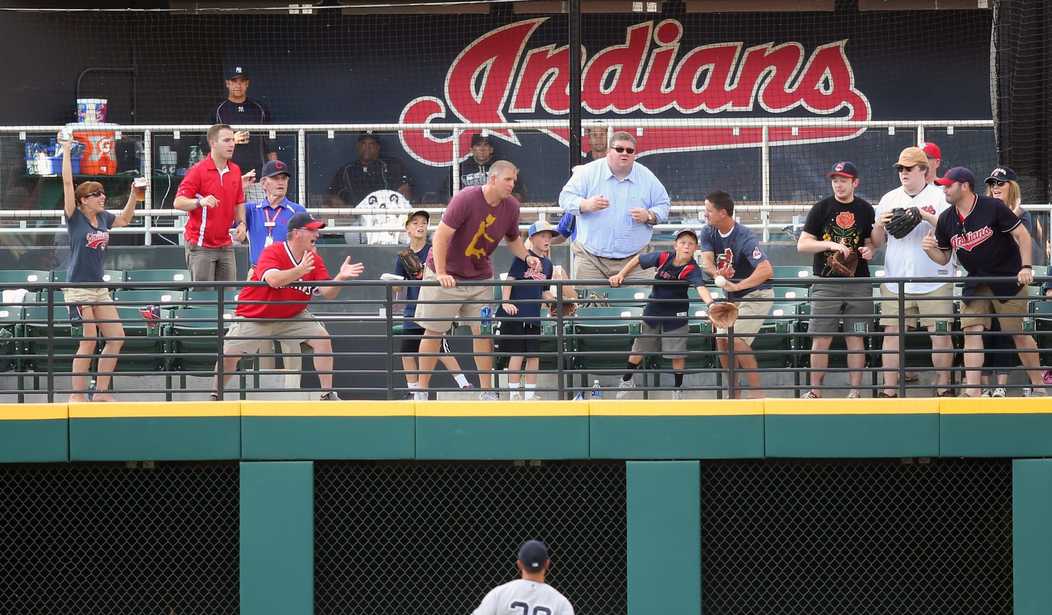Every year baseball team owners gather to fret about their shrinking fan base. And every year there are suggestions that would radically change the game in order to a) create more offense or b) make the game shorter. Because that’s what da yutes want, or something.
The problem with the first is that baseball needs to maintain its anchor to its traditions and stats, even though times change; the second can happen without changing the character of the game.
Baseball’s biggest problem is that the owners are trying to squeeze ever more money out of the current fan base instead of expanding their pie. Here are some decidedly non-revolutionary solutions baseball should try before changing the strike count, or forcing pitchers to face a minimum number of batters.
1. License more (good) video games
Baseball claims its biggest problem is getting kids interested. But if you think they are right that the pace is the problem, then explain the growth of soccer.
Once upon a time, kids learned about players they didn’t see on TV though baseball cards. But like lots of fun things in life, adults and collectors ruined that. Once you could get every card by buying a whole set, or purchasing them on the internet, the fun of waiting for the next series of cards, or having to trade with a friend to complete the set was over.
Now, kids learn players and their stats by playing video games. Mind-bogglingly, Major League Baseball is the only sport that limits its license to one game on one platform—Playstation’s The Show.
That’s right, kids who choose X-Box do not have a good, realistic baseball sim available. RBI Baseball is a joke.
Until that changes, spare me all the youth outreach talk.
2. Kids pricing for games
Live baseball is the most sociable of live sporting events. Best of all, there are no artificial time-outs, so the flow of the game is not marred by interminable and innumerable TV time outs like basketball and football games. Baseball only stops for pitching changes for a few minutes. This makes for good bathroom and concession breaks.
And while baseball tickets are nowhere near as costly as the NFL or NBA (or even major college football or basketball) you still pause before you pack up the whole family.
I don’t see many sellout baseball games. Come on guys, incentivize bringing the whole family if you really care about the yutes.
3. Shorten the season
Baseball opens in the cold and closes in the cold. While some of that is inevitable, it’s getting stupid. Major League Baseball opening day this year was March 28. March 28! Even in the 162-game era and after extending the playoffs, that’s a week earlier than in recent memory.
It’s time to bring back the doubleheader (and combine that with kids pricing). It’s time to find a way to knock at least two weeks off the duration of the baseball season, even if you have to go back to 154 games.
4. Schedule for the weather
Speaking of the cold, this is the most frustrating part of the major league schedule—there is zero attention paid to scheduling based on the weather. Sure, the Texas Rangers and Florida Marlins have to have an equal number of summer games, but at least pay some attention.
My Tigers, for instance, opened the season in Canada! And they are spending about a third of August in Texas. Stop it. Just stop it.
With almost half of the teams in mild or warm weather states, there could be a little attention paid. Not to mention, pitching in the cold is far worse for arms than a few extra batters over the pitch count.
5. Tell the umpires nobody came to see them
Limited replay in baseball became inevitable after Armando Galarraga was robbed of his perfect game on a horrible call.
But it’s time to put umpires on a time clock for making the call. One minute, or the play stands as called.
Most of all, it’s time for major league umpires to grow a thicker skin and not have such big ears.
Hey umpires, you are not part of the game. Nobody came to see you. That player who questioned your strike under his breath is the one under competitive pressure, not you. Laugh it off. You know what you saw. Until somebody goes all Billy Martin on you, let it go.
6. Limit trips to the mound and enforce the pitch timer
Baseball doesn’t have time-outs, but managers and coaches do find ways to stall when they need to. This is one area where actual rule changes can matter without affecting stats or the character of the game.
First, baseball already has a pitch timer in spring training, just to get pitchers acclimated. Add it to the regular season and enforce it. If the pitcher is not in his windup or stretch at 20 seconds, it’s a ball.
However, umpires also need to not give hitters a-time out past 18 seconds on that clock—and quit giving time0-outs for no reason. Make the hitter be in the box at the 10-second mark, or he’s at the mercy of the pitcher.
Finally, each bench gets so many trips to the mound per game. Pitchers can communicate with the manager without needing a time out. This would also mean managers have to manage their bullpens wisely, but limit using those trips for stalling to get pitchers ready.
7. Allow fans in earlier and encourage interaction
As I said, baseball is the most sociable of sports for fans going to just hang out together, and it has traditionally been the most sociable between fans and players. In the past, dads used to bring their sons to watch batting practice and hope to snag an autograph or two.
However, lately gates have not been opening until 90 minutes before the game and players are getting into game focus mode.
Look, I get security, but there is a significant barrier between fans and the players. Let the ones who want to come early and hang out. Plus, it will sell more concessions.
8. Quit limiting the use of highlights
Hey, MLB, you’re in the YouTube and Sports Center era. It’s time to let up on “any rebroadcast, transmission or account of this game without the express permission” nonsense.
Baseball players are more athletic and skilled than ever (despite the lost art of bunting and hitting to the opposite field). And every day they make amazing plays. Push them out. Your persnicketiness over your copyright is keeping people from learning about major league stars who aren’t playing on their team.
Also, highlights from around the league would be far more entertaining during breaks between innings than a hotdog racing a hamburger around the warning track. Get a clue here.
9. Market big stars
This is by far baseball’s biggest problem. While some of the points above have nibbled around the edges of solving this, baseball needs to market its huge stars.
Mike Trout is perhaps the most complete baseball player since the “Mickey, Willie and the Duke” era. And he should be a household name, even among non-fans who all recognize Tom Brady and LeBron James. But other than a few pitchers, only he and Bryce Harper have any name recognition outside the fan base—and it’s not much.
Emphasize storylines: home run and batting crown races. Track whether Trout is in range of the Triple Crown. Justin Verlander pitching at a Cy Young Award level for a World Series contender is the equivalent of the Tom Brady story.
Every other sport markets its stars and its popularity spikes when its stars are popular. Major League Baseball learned nothing from the Michael Jordan era—even though its traditions should tell them differently. Major League Baseball was the sport that created the celebrity athlete.
All of the MLB, not just Yankee Stadium, is truly the House that Ruth Built. It’s time to remember why that is true.









Join the conversation as a VIP Member